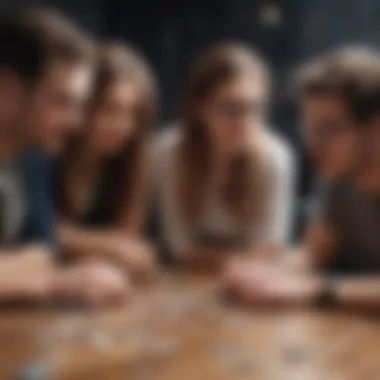The Fascination with Puzzles: A Deep Dive into Challenges


Intro
Puzzles have a remarkable ability to captivate our minds, engaging us in ways that few other activities can. Whether it’s the satisfaction of slotting a final piece into a jigsaw or the thrill of cracking an intricate code, the variety of puzzles available today is staggering. From the classic Sudoku and crossword puzzles to digital challenges that demand razor-sharp intellect, their essential appeal lies in the cognitive workout they provide while also being downright fun.
Across generations and cultures, puzzles have carved out a unique niche, transcending mere entertainment. This exploration will uncover their deep roots, diverse types, and modern iterations while showcasing their cognitive advantages. Let’s take a closer look at what makes puzzles tick and why they remain so irresistible to many.
Game Feature Spotlight
Unique Gameplay Mechanics
Puzzles are all about problem-solving, and gameplay mechanics can vary widely between them. Some require logical reasoning and spatial awareness, while others hinge on pattern recognition and lateral thinking. For instance, think about Sudoku, a game that not only challenges logical thinking but also involves strategic planning. On the other hand, crossword puzzles draw on vocabulary and general knowledge, creating a whole different type of cognitive demand.
- Dexterity: In digital escape rooms, you may need to combine physical and mental dexterity—be it swiping, dragging or tapping to interact with the environment.
- Timer Pressure: Many modern games add a ticking clock to spice up the challenge. Attempting to solve a riddle under time constraints creates an exhilarating sense of urgency.
Art Style and Design
Art plays a subtle yet crucial role in the allure of puzzles. The visual appeal can draw a player in, making the challenge all the more engaging. For instance, consider beautifully illustrated jigsaw puzzles that depict breathtaking landscapes or intricate designs. This artistic touch not only adds to the overall experience but often makes the activity aesthetically satisfying.
In digital puzzles, the landscape shifts dramatically; vibrant graphics and enchanting animations can create immersive worlds. Examples can include puzzle-platformers that merge engaging storylines with eye-catching designs, encouraging players to progress further to unveil more stunning vistas along the way.
Storyline and Characters
While not all puzzles involve narratives, those that do can enrich the experience substantially. Picture a mystery solving game that intertwines complex riddles with an intriguing plot—players are not just solving challenges; they're unraveling a story.
- Character Development: Games like "The Witness" entice players not through characters but through a narrative of solitude and exploration. Each puzzle reveals a layer of an overarching mystery.
- Narrative-driven Puzzles: Conversely, titles such as "Professor Layton" combine puzzles with rich storytelling. Each puzzle feels like a piece of a larger narrative puzzle, enhancing the overall immersion.
"Puzzles are not merely challenges; they're gateways to worlds filled with intrigue and intellect."
Understanding Puzzles
Grasping what makes puzzles so fascinating lays the foundation for appreciating their charm and appeal. In today’s fast-paced society, riddles and conundrums offer us not just moments of diversion but a chance to flex our mental muscles. Through solving puzzles, we engage in a cognitive dance, sharpening our reasoning skills while experiencing a sense of achievement when we conquer these challenges.
Puzzles are multifaceted; they appeal to our innate curiosity and drive for mental stimulation. They often require creativity, critical thinking, and analytical skills, allowing us to plunge into realms of logic and imagination. Furthermore, puzzles have a unique ability to foster social interaction, be it through jigsaw puzzles solved with family, crossword competitions among friends, or solving virtual puzzles in gaming platforms. The intricate relationship that puzzles have with our thought processes and social dynamics positions them as essential elements in our lives.
What Defines a Puzzle
A puzzle can be broadly defined as a problem or enigma that demands ingenuity and skill to resolve. This definition encompasses a diverse range of puzzles, from the simple crossword to intricate escape room challenges. At its core, a puzzle requires the participant to muster up a combination of reasoning, creativity, and sometimes a sprinkle of luck to unlock its secrets.
Puzzles can manifest in various forms:
- Logic puzzles challenge our deductive reasoning abilities. They require combing through information to arrive at a conclusion. An example is the classic "who lives in which house" type of scenario, where each clue adds a piece to the bigger picture.
- Word puzzles, such as crosswords, not only boost vocabulary but also provide a workout for our memory. They involve recalling terms while also thinking about how to fit them into a grid structure.
- Number puzzles, like Sudoku, demand both logical thinking and numerical skills. They’re perfect for those who enjoy patterns and systematic approaches.
- Physical puzzles involve tactile manipulation, like jigsaw puzzles, where the challenge lies in both the shapes and the image being created.
- Finally, digital and video game puzzles often integrate various factors, from problem-solving to real-time strategy and spatial awareness.
Cognitive Benefits of Solving Puzzles
Engaging with puzzles isn't just enjoyable; it can also serve as a mental workout, offering numerous cognitive benefits. Studies show that solving puzzles can enhance our memory and improve our problem-solving skills.
- Memory Enhancement: As we tackle puzzles, we often need to remember clues, previous attempts, or even the rules of the puzzle itself. This continuous engagement with memory reinforces neural connections in the brain.
- Critical Thinking: Each puzzle requires us to reach conclusions based on logic. By navigating through intricate clues, we enhance our ability to think critically. Puzzles often require one to argue from premises to solutions, refining our reasoning skills.
- Stress Relief: Engaging in puzzles can also be a form of mindfulness, pulling us into a flow state where our worries dissipate. Concentrating on a puzzle offers a break from the chaos of life, reducing anxiety levels.
- Increased IQ: Some research suggests that regular engagement with puzzles can result in increased intelligence over time. The mental dexterity acquired from this activity can translate to better performance in academic and work environments.
"Puzzles are not just games; they are the keys to unlocking the hidden potential of our minds."
Types of Puzzles
Puzzles come in various shapes and forms. Understanding the different types of puzzles is crucial, especially when considering their unique characteristics and how they cater to diverse preferences. Each category of puzzle appeals to distinct cognitive skills, from logical reasoning to linguistic prowess, thus enabling a broad spectrum of engagement for enthusiasts of all ages. Exploring these puzzle types not only enriches our appreciation of the art of puzzle-making but also highlights how they can serve as tools for intellectual stimulation and recreation.
Logic Puzzles
Logic puzzles represent a fascinating realm of problem-solving that often involves reasoning and deductive thinking. They frequently require solvers to piece together various clues to arrive at a conclusion. Think of a classic situation, where there are five houses painted different colors on a street, and each house is inhabited by individuals from different countries, each with distinct pets, drinks, and professions. The challenge is to figure out who owns the fish, using clues that interlink these aspects.


Solving logic puzzles sharpens critical thinking skills, enhances analytical capabilities, and fosters a methodical approach to tackling complex problems. Interestingly, their appeal often lies in the satisfaction one derives from cracking the code, leading to a rewarding sense of accomplishment once the solution is uncovered.
Word Puzzles
Word puzzles, as the name suggests, revolve around the use of language and vocabulary. Popular formats include crosswords, anagrams, and word searches. Engaging in word puzzles not only sharpens linguistic prowess but also expands our vocabulary. For instance, while deciphering a countdown where one must form new words from a set of given letters, players often stumble upon terms they may not even knew existed.
The beauty of word puzzles lies in their versatility; they can cater to varied skill levels, therefore appealing to everyone from casual players to seasoned wordsmiths. Moreover, they often encourage collaborative efforts—think of friends congregating over a crossword puzzle during a gathering, fostering camaraderie through team effort.
Number Puzzles
Number puzzles, like Sudoku or Kakuro, challenge players' numerical reasoning and logical placement. These types of puzzles engage individuals in a systematic exploration of numbers and relationships, often leading to a focused and immersive experience. For instance, in Sudoku, players fill a 9x9 grid so that every column, row, and 3x3 section contains the numbers 1-9 without repetition. This demands not only mathematical skills but also strategic foresight to navigate potential pitfalls.
Participating in number puzzles can be particularly beneficial for enhancing mental acuity. They promote an understanding of patterns and sequences, which can be invaluable in everyday problem-solving scenarios, from budgeting to scheduling tasks effectively.
Physical Puzzles
Physical puzzles involve tactile interaction, adding a sensory dimension to the activity. Jigsaw puzzles exemplify this type, inviting players to fit intricate pieces together to form a complete image. Interestingly, some enthusiasts derive comfort from these methods of assembly, often likening the experience to putting together pieces of their life, signaling resolution on a subconscious level.
Additionally, physical puzzles, like Rubik’s Cube, introduce spatial reasoning, allowing participants to visualize and manipulate objects mentally. They can also provide a welcome break from screen time in an increasingly digital world, encouraging a more engaged and active form of entertainment.
Digital and Video Game Puzzles
Finally, we arrive at digital and video game puzzles—a dynamic blend of technology and cognitive challenges. Games like Portal or The Witness intertwine puzzles into their narratives, engaging players in immersive environments where problem-solving is essential to progress.
These puzzles cater to a generation immersed in digital landscapes, often merging intricate storylines with logical or spatial challenges. The interactivity of video game puzzles can significantly boost engagement and enjoyment, creating a sense of urgency or excitement that keeps players invested.
Digital puzzles also offer structured pathways for learning new skills, where players can hone cognitive abilities while navigating through obstacles and narratives. They encapsulate a modern evolution of traditional puzzles, reinforcing the notion that the puzzle landscape is constantly evolving.
The Historical Context of Puzzles
The backdrop of puzzles offers not just a glimpse into their past but an understanding of why they are so deeply woven into human culture. From ancient civilizations to modern times, puzzles have served as a vital form of both entertainment and intellectual engagement. The historical context of puzzles illustrates their evolution, revealing insights into society's changing values, challenges, and the fundamental human desire for problem-solving.
Ancient Origins of Puzzles
Puzzles, in various forms, have existed since the dawn of human ingenuity. Early examples date back to ancient civilizations where they were more than just pastimes; they were tools for cognitive development and social interaction. The oldest known puzzle might be the Stomachion, attributed to Archimedes around 250 BCE. This mathematical puzzle involved arranging pieces into a square and laid early groundwork for combinatorial reasoning.
Furthermore, ancient cultures, such as the Egyptians and Greeks, created riddles that not only entertained but also educated the populace. Hieroglyphs often contained puzzles, requiring deciphering skills that sharpened cognitive abilities. In some cases, these puzzles reflected social hierarchies or moral lessons, subtly blending entertainment with ethical education.
In the East, puzzles also took root quite early. The Chinese had their own versions of puzzles, such as the famous Tangram, believed to have been invented in the early 19th century. It consisted of seven flat pieces that could be arranged to form various shapes, prompting creativity and enhancing spatial awareness. This puzzle exemplifies the cultural emphasis on art and harmony in Chinese history.
Evolution Through the Ages
As time marched on, puzzles transformed significantly, mirroring societal shifts and technological advancements. The Middle Ages saw the rise of logic puzzles and riddles, often integrated into literature and folklore. For example, the Sphinx's riddle found in Greek mythology not only served to challenge characters like Oedipus, but it also symbolized the idea of wisdom through knowledge.
With the Renaissance, puzzles took a leap forward. The invention of the printing press allowed riddles and logic problems to be proliferated, reaching a larger audience than ever before. Compendiums of puzzles sprang up, inviting dialogue, competition, and camaraderie among scholars and the general public alike.
Skipping ahead to the 19th century, mechanical puzzles emerged, leading to iconic inventions like the Rubik's Cube, which would dominate the puzzle world in the late 20th century. This particular puzzle encapsulates a blend of mathematics, art, and psychology, appealing to a broad spectrum of problem-solvers, from children to seasoned strategists. Moreover, the digital age introduced a fresh wave of puzzles, with exceptions becoming interactive and available at our fingertips. Online platforms offer anything from simple crossword puzzles to complex escape room games, continuously reshaping how we experience challenging problems.
"Puzzles are not just a play on words or numbers; they challenge our mental framework and invite us to see the world through a multifaceted lens."
Puzzles in Popular Culture
Puzzles have permeated various facets of popular culture, seeping into our daily lives in ways that often go unnoticed. The significance of puzzles extends far beyond mere entertainment; they serve as a reflection of the intellectual curiosities of society and present unique avenues for storytelling and engagement. Through their portrayal in movies, television, and literature, puzzles not only engage the mind but also spark curiosity and provoke thought. This section aims to examine how puzzles have been integrated into popular culture and their consequent impacts on audience perceptions and experiences.
Movies and Television
In the realm of movies and television, puzzles are often woven into narratives as plot devices. They can challenge both characters and viewers alike, creating an immersive experience that enhances the storyline. Films such as The Imitation Game depict historical figures who mastered the art of decoding, illustrating the real-life importance of puzzles in solving complex problems. This engaging portrayal can inspire audiences to appreciate the nuances behind puzzles, transcending entertainment.


Moreover, television shows like Sherlock incorporate puzzles not only to keep viewers on their toes but also as a means of showcasing the protagonists' intellect. The character of Sherlock Holmes turns every riddle into a piece of a larger puzzle, allowing fans to engage in their own deductive reasoning as they follow along. This technique encourages active participation from the audience, making them feel part of the narrative.
"In films and shows, puzzles push the plot forward and ignite the viewer's need to think."
Notably, escape room-themed episodes have gained traction, melding interactive entertainment with television. These segments invite viewers to solve puzzles alongside characters, presenting a shared experience that resonates deeply with those who enjoy a challenge. The clever integration of puzzles, therefore, sharpens critical thinking and cultivates a sense of community among puzzle enthusiasts.
Literature and Riddles
Literature, too, has a rich history of incorporating puzzles and riddles, acting as a catalyst for deeper engagement with texts. Classic works like The Hobbit by J.R.R. Tolkien not only include riddles as a form of dialogue but also highlight their significance in character development and plot progression. Gollum's riddles are not just playful banter; they represent fundamental themes of wisdom, survival, and wit—elements that resonate with readers beyond the pages.
Riddles serve a dual purpose in literature; they challenge the reader and function as plot devices to advance the story. Authors frequently use riddles to create suspense, forcing readers to pause and reflect. This interactive component can transform mere reading into an active mental challenge, drawing the reader deeper into the literary world.
In contemporary contexts, blogging and social media platforms like Reddit have made it easy for users to share riddles and puzzles, fostering a vibrant community around literature and challenges. This modern twist has revived interest in classic riddles while encouraging creativity.
In both movies and literature, puzzles solidify their role as engaging elements that motivate audiences to think critically and remain engaged. As they continue to evolve, puzzles will likely find even more innovative representations within popular culture, maintaining their allure across generations.
The Psychology of Puzzles
Exploring the psychological dimensions of puzzles unveils the intricate interplay between our minds and these captivating challenges. Puzzles are not just simple diversions; they ignite our cognitive faculties, engaging a wide array of psychological processes. Understanding this dynamic is crucial, particularly if we wish to appreciate why puzzles continue to enrapture minds of all ages, especially within the gaming community.
Motivation Behind Solving Puzzles
The drive to tackle puzzles can largely be linked to a few compelling motivators, tightly interwoven with human instincts and desires. For many individuals, the thrill comes from the challenge itself. Completing a puzzle gives a sense of achievement akin to climbing a mountain or finishing a marathon. The allure of solving something complex can act as a beacon, pulling individuals in with promises of personal growth and understanding.
One can consider this intrinsic motivation as a push towards mastering our environment. When someone engages with a puzzle, they don’t simply seek to solve it; they crave the satisfaction that emerges from untangling the knot of confusion—one piece at a time. This can be particularly evident in logic games, where trial and error cycles often lead to 'aha' moments that trigger those feel-good hormones.
"Solving puzzles is like cracking a code. Each attempt is a step closer to unveiling the hidden solution."
Another motivational factor is the social aspect. Puzzles can ignite camaraderie among friends and family. Think of a game night where everyone gathers around a table, the flickering light of a lamp illuminating their focused expressions as they collaborate to fit together pieces of a complex jigsaw puzzle. The discussions and shared experiences can make the endeavor feel less solitary and more communal, enhancing motivation significantly.
Additionally, with the rise of digital puzzles and online platforms, the competition adds a layer of excitement. Gamers often find themselves vying for top scores or quickest completion times, which elevates engagement levels. The psychological theory of gamification brilliantly applies here, where elements of game design enhance the motivation thresholds, leading participants to push harder and think deeper.
Frustration and Reward
Every puzzle comes with its fair share of frustration, a necessary ingredient in the mix. The relationship between frustration and reward is deeply entrenched in the psychology of problem-solving. When confronting a complex challenge, feelings of vexation can quickly bubble to the surface—leading many to simply throw in the towel or take a step back.
However, it’s essential to recognize that frustration can catalyze cognitive growth. Every setback encountered when trying to solve a puzzle can teach resilience. Visionaries often cite their failures as stepping stones that lead to eventual success. By grappling with difficult riddles or intricate strategies, individuals fine-tune their problem-solving techniques.
Moreover, the sense of relief and joy upon finally achieving the solution creates a profound satisfaction. This reward can feel almost euphoric, as it commingles with relief, making the player feel strong, competent, and insightful. Thus, the cycle of struggle followed by triumph is very much like a rollercoaster ride of emotions.
Engaging with puzzles, especially in settings like escape rooms or immersive games, showcases amplified levels of both frustration and reward. Players facing a time limit or unexpected twists may find their joy heightened upon overcoming tricky obstacles, further solidifying their desire for future puzzles.
Innovative Puzzle Experiences
The landscape of puzzles has evolved remarkably, driven by creativity and technology. Innovative puzzle experiences provide fresh avenues for engagement, pushing the boundaries of traditional problem-solving methods. These experiences blend physical and digital realms, creating a unique fusion that attracts a wide audience. Whether you stand at the brink of completing an escape room or you interact with an augmented reality puzzle, the thrill and satisfaction derived from these activities embark you on a journey of the mind.
Escape Rooms
Escape rooms are often ahead of the curve when it comes to interactive experiences. These physical adventure games require players to solve a series of puzzles under a time constraint, enhancing teamwork and communication. The adrenaline rush that surges when the clock is ticking can often lead to unexpected bursts of creativity and camaraderie. While some may see escape rooms as simple entertainment, they actually serve as a poignant reminder of the brain's capabilities when thrust into a corner.
The intricate themes and narratives of escape rooms pull players into vivid scenarios, encouraging immersion as one tackles challenges with friends or strangers. Some important aspects to consider include:
- Team Dynamics: Communication is key; not every team member may think the same way, which could lead to innovative solutions.
- Variety of Puzzles: From riddles to logic puzzles, the diversity keeps the experience fresh and engaging.
- Immersive Environments: Escape rooms often feature meticulously crafted settings that enhance the thematic joy.
Such engaging environments enable players to become fully absorbed in the task at hand, fostering both problem-solving skills and social connections.
Augmented Reality Puzzles


On the cutting edge, augmented reality puzzles take the engagement to another level. These puzzles intertwine physical and digital worlds, allowing users to interact with 3D elements through devices like smartphones or tablets. As players point a device at a physical object, the screen comes to life with additional layers of challenges, animations, or clues.
Key elements of augmented reality puzzles include:
- Interactive Learning: This tech enables learning through experience and experimentation.
- Accessibility: Players can engage from various locations, breaking the limitation of a physical space.
- Enhanced Visualization: Complex concepts can be perceived in a simpler way through visual aids.
"The player is not just an observer but an active participant, bridging the gap between imagination and reality."
This form of puzzles has rapidly gained traction, especially among gamers who appreciate both strategy and creativity. Combining technology with play, these experiences can typically be tailored for various skill levels, ensuring broad appeal across age groups.
As the puzzle landscape continues to evolve, innovative experiences like escape rooms and augmented reality puzzles signify a shift toward more immersive and engaging forms of intellectual challenge. They speak to a broader evolution of puzzle-solving, where creativity intersects with technology, crafting a new narrative in puzzle exploration.
The Future of Puzzles
As we maneuver through the twists and turns of the twenty-first century, puzzles are not just a nostalgic pastime; they are evolving into a realm of limitless potential. This transformation is not only important for engaging the modern audience but also highlights how our society values critical thinking and problem-solving skills. The unique blend of technology and creativity is fostering a new age of puzzles, where boundaries are pushed, and imagination knows no limits.
Technological Influence on Puzzles
In today’s digital era, technology has become the wind beneath the wings of the puzzle industry. It has changed the landscape of how puzzles are created, shared, and experienced. Here are a few key elements that illustrate the impact of technology:
- Interactive Experiences: With augmented reality and virtual reality, puzzles now create immersive environments that captivate players in new ways. The use of these technologies helps blur the lines between the physical and digital spheres, making solving puzzles feel more like an adventure.
- Accessibility and Community: Platforms like reddit.com and social media groups allow puzzle enthusiasts to connect across the globe, share their favorite challenges, and work together on solutions. This sense of community fosters collaboration and motivation, drawing in new players while keeping seasoned solvers engaged.
- Personalization: Advanced algorithms in puzzle apps allow users to tailor their experiences to their preferences. Gamers can select challenges that match their skill levels or even themes that resonate with them, ensuring they remain engaged without feeling overwhelmed.
The increasing integration of technology positions puzzles as not just solitary activities but pathways to community and connection.
Sustainability in Puzzle Creation
As society grows more conscious of environmental issues, the puzzle industry is adapting to embrace sustainability, making it a critical consideration for the future.
- Material Choices: Many puzzle manufacturers are switching from traditional materials to eco-friendly options. For example, puzzles made from recycled paper or bamboo are becoming common, reducing waste and encouraging responsible consumption.
- Ethical Production: Emphasizing fair labor practices and responsible sourcing of materials, companies are becoming more transparent about how their puzzles are made. Consumers increasingly demand accountability, which is steering the industry toward more sustainable practices.
- Digital Solutions: Digital puzzles completely eliminate the need for physical resources. Not only do they provide instant access to a wide array of challenges, but they also lessen the environmental footprint that physical puzzles may leave behind.
Adopting sustainable practices is not just a trend; it’s becoming essential. As discussions surrounding climate change and sustainability grow louder, the puzzle industry has a unique opportunity to lead by example.
"The future of puzzles blends entertainment with responsibility, crafting a narrative that entertains while also safeguarding our planet."
With these innovations and conscientious approaches, the future of puzzles promises to be as engaging as it is sustainable. As we look ahead, it’s clear that puzzles are far from mere entertainment; they hold the key to social interaction, educational opportunities, and environmental stewardship.
Closure: The Enduring Fascination with Puzzles
Puzzles have a unique way of weaving themselves into the fabric of our lives, transcending age, culture, and even technological advancements. In this final section, it is, crucial to reflect on the importance of puzzles in our daily routines and intellectual landscape. Beyond just being a pastime, they represent a bridge between leisure and learning. They offer an effective means to enhance cognitive abilities while simultaneously providing a much-needed escape from the grind of everyday responsibilities.
"Puzzles give us the chance to unlock our hidden potential, challenging but rewarding in equal measure."
The appeal of puzzles lies not only in the satisfaction derived from their completion but also in their power to foster community and connection among enthusiasts. Whether it’s a crossword puzzle shared over breakfast or solving a complex riddle with friends, these activities cultivate a spirit of collaboration and conversation. The act of working together can lead to stronger relationships and new friendships, demonstrating that puzzles can be more than just solitary challenges.
Moreover, as we shift towards a more digital world, puzzles adapt and evolve. New forms emerge, such as mobile apps and online escape rooms, providing access to engaging content without the need to gather physically. The future of puzzles looks bright, with innovative solutions enhancing their accessibility and the ability to bring people together.
Reflection on Their Importance
Understanding puzzles' depth and significance can reshape how we view them. They are not merely pastimes; they’re tools for development and interaction. Take, for example, how puzzles can enhance problem-solving skills. Regularly engaging with them encourages a methodical approach to challenges. Additionally, the benefits extend to mental health; they offer stress relief and a way to achieve a state of mindfulness.
Here are a few key aspects to consider about the significance of puzzles:
- Cognitive Enhancement: Regular engagement with puzzles can improve memory, reasoning, and analytical skills.
- Social Interaction: Puzzles can be a communal experience, forcing collaboration and discussion.
- Cultural Reflection: Puzzles often reflect societal trends and dynamics, offering a glimpse into different cultural contexts.
Encouraging Engagement with Puzzles
Encouraging deeper interaction with puzzles can lead to a richer appreciation of this multifaceted activity. An effective approach is to create environments where puzzle-solving can flourish. This can be achieved through bookstores or cafes featuring puzzle nights, or perhaps local communities hosting puzzle-solving competitions.
Moreover, it is essential to introduce varied puzzle formats to cater to different interests and strengths. Not everyone may thrive with logic puzzles; for some, word puzzles like crosswords or even Sudoku might spark inspiration. Digital platforms also provide an excellent way to keep engagement high, offering challenges that evolve in difficulty over time.
To facilitate puzzle enthusiasm:
- Host Events: Organize puzzle competitions or themed nights to attract various age groups.
- Promote Online Communities: Encourage discussions on platforms like Reddit, where people can share tips and challenges.
- Leverage Social Media: Use social media platforms like Facebook to create engagement through groups or challenges.







